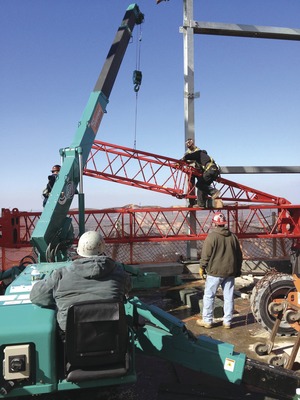
Bigger is not always better. Such is the case of a small lifting machine, called a mini-crane, that has been advancing rigging and hoisting work needed to replace a large tower crane that partially collapsed in Midtown Manhattan last October during Superstorm Sandy.
The unusual work requires crews to cut down, remove and then replace a crane-jib superstructure that is bolted to a tower mast about 1,000 ft in the air, a task that has called for specialized equipment and engineering. According to experts on the job, a tower crane has never been replaced at that height before.
"This is unprecedented," says Michael Alacha, assistant commissioner for engineering and emergency operations for New York City's Dept. of Buildings. "Typically, they jack the crane down to 90 feet, then use a service crane to remove it." Completion of the One57 skyscraper, located on West 57th Street, partly hinges on the delicate operation.
The Favelle Favco M440 crane superstructure was damaged in the storm when a gust of wind lifted the boom, flipping it backward over its counterweight. Due to extensive damage, it could not be jacked down for service. After tethering the jib to the building, crews wrapped the steel structure in a cocooned scaffold and removed it using cut-off saws and chain falls. In January, they brought the teal-colored mini-crane, made by Japan-based Maeda, to the roof. The tiny model MC305-2 has since been handling loads on top of the 1,000-ft-tall skyscraper.
"First, we had to remove steel that was on the roof with the Maeda crane, and then we stripped away the heel section and parts of the boom stops of the damaged crane," says Joe Volpe, a master rigger and owner of Staten Island, N.Y.-based J.V. Trucking & Rigging LLC.
Volpe, whose firm is running the petite crawler crane for construction manager Lend Lease, says the small machine has made a big difference. Rated for a maximum 6,560 lb, it can lift a load weighing 1,700 lb to a height of 41 ft—which is what crews needed to set up a 35-ton Timberland stiff-leg derrick on the roof.
The crawler is "a very compact machine," says Volpe, noting that it has an onboard computer "just like a big crane." Erected in February, the derrick will soon hoist a Favco M220 jib to the top of the existing mast. A 440 jib was not available, so engineers opted for the next size down.
Mini-cranes serve a small yet steadily expanding market, says Tony Inman, president of Houston-based Maeda USA. "The mini-crane can take the hook to the lift," he says. "We've had lots of them on top of buildings." The MC305-2 costs about $120,000 to buy and $8,500 to rent per month, including insurance.
Equipped with remote controls, mini-cranes can squeeze into tight spaces. The 9,100-lb unit at One57 journeyed to the roof in an elevator, but crews first had to remove the outriggers, disconnect the hook block and drain the hydraulics to meet the elevator's 7,000-lb weight limit. "Then, we drove it right onto the house car," Volpe says. The dual-fuel diesel-electric rig was reassembled on the roof.
The city's Dept. of Buildings is now reviewing plans to have the derrick lift the 150-ft-long boom to the top of the tower, which will require nearby building evacuations. "I want to make sure all the I's are dotted and T's are crossed," says Commissioner Robert LiMandri, who adds that the lifting may get under way this month. Once the crane is up, about four months of picks are needed to finish the building.
Because the derrick cannot lift safely in winds greater than 20 mph, the prep work has been complicated. "We have wind meters all over the building," says Volpe. "We are averaging two to three days a week, fighting the wind."









Post a comment to this article
Report Abusive Comment